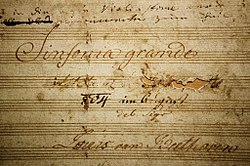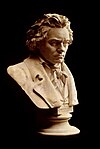Symphony No. 3 (Beethoven): Difference between revisions
m added internal link to Mozart |
|||
| Line 25: | Line 25: | ||
==Critical reception== |
==Critical reception== |
||
The work is a milestone in the history of the classical symphony for a number of reasons. The piece is about twice as long as symphonies by [[Haydn]] or Mozart — the first movement alone is almost as long as many [[Classical music era|Classical]] symphonies. The work covers more emotional ground than earlier works had, and is often cited as the beginning of the Romantic period in music.{{Fact|date=February 2007}} The second movement, in particular, displays a great range of emotion, from the misery of the main [[funeral march]] theme, to the relative solace of happier, major key episodes. The finale of the symphony shows a similar range, and is given an importance in the overall scheme which was virtually unheard of previously{{Fact|date=February 2007}} — whereas in earlier symphonies, the finale was a quick and breezy finishing off, here it is a lengthy set of [[variation form|variations]] and [[fugue]] on a theme Beethoven had originally written for his ballet music ''[[The Creatures of Prometheus (Beethoven)|The Creatures of Prometheus]]''. |
The work is a milestone in the history of the classical symphony for a number of reasons. The piece is about twice as long as symphonies by [[Haydn]] or [[Mozart]] — the first movement alone is almost as long as many [[Classical music era|Classical]] symphonies. The work covers more emotional ground than earlier works had, and is often cited as the beginning of the Romantic period in music.{{Fact|date=February 2007}} The second movement, in particular, displays a great range of emotion, from the misery of the main [[funeral march]] theme, to the relative solace of happier, major key episodes. The finale of the symphony shows a similar range, and is given an importance in the overall scheme which was virtually unheard of previously{{Fact|date=February 2007}} — whereas in earlier symphonies, the finale was a quick and breezy finishing off, here it is a lengthy set of [[variation form|variations]] and [[fugue]] on a theme Beethoven had originally written for his ballet music ''[[The Creatures of Prometheus (Beethoven)|The Creatures of Prometheus]]''. |
||
Music critic [[J. W. N. Sullivan]] writes<ref name = "Wiſdom">[http://www.wisdomportal.com/EroicaSymphony.html Eroica Symphony], Wiſdom Portal.</ref> that the first movement is an expression of Beethoven's courage in confronting his deafness, the second, slow and dirgelike, depicting the overwhelming despair he felt, the third, the scherzo, an "indomitable uprising of creative energy" and the fourth an exuberant outpouring of creative energy. |
Music critic [[J. W. N. Sullivan]] writes<ref name = "Wiſdom">[http://www.wisdomportal.com/EroicaSymphony.html Eroica Symphony], Wiſdom Portal.</ref> that the first movement is an expression of Beethoven's courage in confronting his deafness, the second, slow and dirgelike, depicting the overwhelming despair he felt, the third, the scherzo, an "indomitable uprising of creative energy" and the fourth an exuberant outpouring of creative energy. |
||
Revision as of 13:42, 2 April 2008

The Symphony No. 3 in E flat major (Op. 55) by Ludwig van Beethoven (known as the Eroica, Italian for "heroic") is a work sometimes cited as marking the beginning of musical Romanticism and the end of the Classical Era.
Dedication and premiere
Beethoven originally dedicated the symphony to Napoleon Bonaparte. Beethoven admired the ideals of the French Revolution, and Napoleon as their embodiment, but the composer was so disgusted when Napoleon proclaimed himself Emperor of the French in May 1804, that he went to the table where the completed score lay, took hold of the title-page and scratched the name Bonaparte out so violently that he created a hole in the paper. He later changed the title to Sinfonia eroica, composta per festeggiare il sovvenire d'un grand'uomo ("heroic symphony, composed to celebrate the memory of a great man"). His assistant Ferdinand Ries tells the story in his biography of Beethoven:
In writing this symphony Beethoven had been thinking of Buonaparte, but Buonaparte while he was First Consul. At that time Beethoven had the highest esteem for him and compared him to the greatest consuls of ancient Rome. Not only I, but many of Beethoven's closer friends, saw this symphony on his table, beautifully copied in manuscript, with the word "Buonaparte" inscribed at the very top of the title-page and "Ludwig van Beethoven" at the very bottom. …I was the first to tell him the news that Buonaparte had declared himself Emperor, whereupon he broke into a rage and exclaimed, "So he is no more than a common mortal! Now, too, he will tread under foot all the rights of man, indulge only his ambition; now he will think himself superior to all men, become a tyrant!" Beethoven went to the table, seized the top of the title-page, tore it in half and threw it on the floor. The page had to be re-copied and it was only now that the symphony received the title "Sinfonia eroica."[1]
Beethoven wrote most of the symphony in late 1803 and completed it in early 1804. The symphony was premiered privately in summer 1804 in his patron Prince Joseph Franz Maximilian Lobkowitz's castle Eisenberg (Jezeri) in Bohemia. The first public performance was given in Vienna's Theater an der Wien on April 7 1805 with the composer conducting.
Instrumentation
The symphony is scored for 2 flutes, 2 oboes, 2 clarinets in B flat, 2 bassoons, 3 horns in E flat and C, 2 trumpets in E flat and C, timpani and strings.
Form
The piece is in four movements:
- Allegro con brio
- Marcia funebre: Adagio assai
- Scherzo: Allegro vivace
- Finale: Allegro molto
Performances run between 40 and 60 minutes, but typically around 50.[citation needed]
In the first movement, Beethoven indicates that the exposition is to be repeated. This repeat, generally omitted in performances before the late 1950s, is nowadays usually observed.
Critical reception
The work is a milestone in the history of the classical symphony for a number of reasons. The piece is about twice as long as symphonies by Haydn or Mozart — the first movement alone is almost as long as many Classical symphonies. The work covers more emotional ground than earlier works had, and is often cited as the beginning of the Romantic period in music.[citation needed] The second movement, in particular, displays a great range of emotion, from the misery of the main funeral march theme, to the relative solace of happier, major key episodes. The finale of the symphony shows a similar range, and is given an importance in the overall scheme which was virtually unheard of previously[citation needed] — whereas in earlier symphonies, the finale was a quick and breezy finishing off, here it is a lengthy set of variations and fugue on a theme Beethoven had originally written for his ballet music The Creatures of Prometheus.
Music critic J. W. N. Sullivan writes[2] that the first movement is an expression of Beethoven's courage in confronting his deafness, the second, slow and dirgelike, depicting the overwhelming despair he felt, the third, the scherzo, an "indomitable uprising of creative energy" and the fourth an exuberant outpouring of creative energy.
Horn solo anecdote
In the first movement, the solo horn enters with the main theme four measures before the "real" recapitulation. Beethoven's disciple Ferdinand Ries recounted:[3]
The first rehearsal of the symphony was terrible, but the hornist did in fact come in on cue. I was standing next to Beethoven and, believing that he had made a wrong entrance, I said, 'That damned hornist! Can't he count? It sounds frightfully wrong.' I believe I was in danger of getting my ears boxed. Beethoven did not forgive me for a long time.
Modern usage
- The second movement, a funeral march, is frequently performed on memorial occasions. Serge Koussevitzky performed it to commemorate the death of President Franklin Delano Roosevelt,[1] and Bruno Walter did the same for Arturo Toscanini.[2]
- The second movement was also used as a funeral dirge during the memorial service following the "Munich massacre" terrorist attacks during the 1972 Summer Olympics. It was played by the Munich Philharmonic Orchestra.
- Richard Strauss's mourning music Metamorphosen is based on the theme of the funeral march from the Eroica, and combines harmonically distorted variants of its main motifs. At the very end the opening bars of the funeral march are quoted literally in the bass.
References
- ^ Eroica, Napoleon Series.
- ^ Eroica Symphony, Wiſdom Portal.
- ^ Ries, Ferdinand (1987). Beethoven Remembered: The Biographical Notes of Franz Wegeler and Ferdinand Ries. Arlington, Va.: Great Ocean Publishers. p. 69. ISBN 0-915556-15-4.
{{cite book}}: Unknown parameter|coauthors=ignored (|author=suggested) (help)
- George, Christopher T. (December 1998), "Beethoven: Letters, Journals and Conversations", Napoleonic Scholarship:The Journal of the International Napoleonic Society, vol. 1, no. 2, ISBN 0837198992
{{citation}}:|contribution=ignored (help)
External links
- Complete Symphonies Free download featuring Maximianno Cobra conducting the Europa Philharmonia Orchestra
- Eroica website from SF Symphony's 'Keeping Score' with Analysis, Background and Commentary by MTT (needs Flash).
- Program notes for the San Francisco Symphony (Ries anecdote)
- Complete Eroica Discography
- A site about Eroica.
- Full Score of Beethoven's Third Symphony.
- Complete performance by the Philadelphia Orchestra.
- Free scores by Symphony No. 3 at the International Music Score Library Project (IMSLP)

